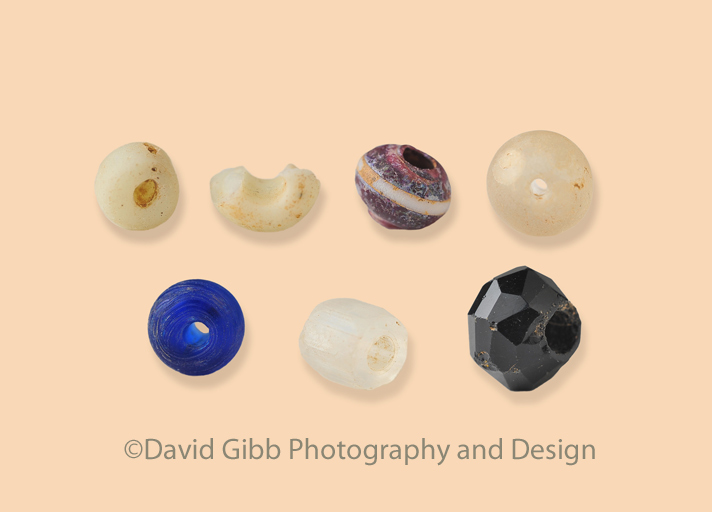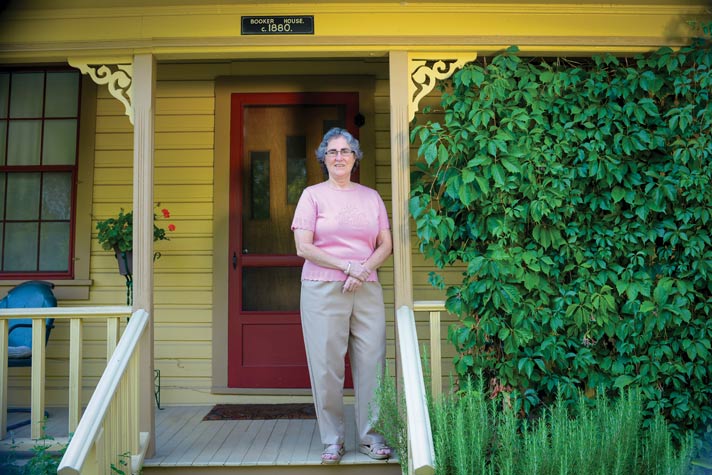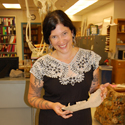Digging Jacksonville – March 2017
I have been working with SOULA on the archaeology of my historic home and property for more than a decade. Each time I need to renovate, update, or improve the home and grounds, artifacts turn-up. Evidence of Euro-American and Chinese presence are common on the property, but previous to these finds, there was scant evidence of a Native American presence. The trade beads pictured above were found while doing repair work on the front of my house and during work on a deck.
Trade beads were a common commodity with early explorers and traders, who used them in exchange for furs or other supplies from Native Americans. Lewis and Clark requested a quantity of “a coarse cheap bead, imported from China” for their expedition. The Hudson’s Bay Company is the best known fur trading company that used glass trade beads in our region, but the Russian-American Company also traded along the west coast, at least as far south as Fort Ross in northern California.
Native Americans were using beads for centuries before contact with outsiders. These beads were made of bone, stone, wood, shells and seeds and were used for trade and personal adornment on clothing, bags, necklaces, anklets, bracelets, piercings, etc. The new glass beads thus quickly found a market.
Trade beads were manufactured in many places, including China, Bohemia, Amsterdam, and Venice. It is not possible to tell where a bead came from just by looking at it, but it is often possible to tell how it was made. Drawn beads are very common and were made by workers taking the ends of a molten blob of hollow glass and running in opposite directions to stretch it until the desired thickness was achieved. The long tube was cut into small sections and individual beads were then tumbled to remove sharp edges and give them a more barrel-shaped look.
Wound beads are also quite common. These generally look very spherical and were made by winding hot glass around a wire or mandrel and spinning them in the heat to help shape them. Mold-pressed beads were made by taking the hot glass and pressing it into a mold to achieve the desired shape. This glass may have started out as a drawn or wound bead. Beads were sometimes faceted, either by hand (grinding or shaping with wooden paddles) or by the shape of the mold.
To me, the wildest find was an essentially-intact hollow, blown glass bead. How it survived whole after being dropped, buried, having a house built over it, being dug up and moved, and then screened out of the dirt is amazing. Fort Vancouver has a collection of over 100,000 trade beads but only a handful are blown glass, and most of these are fragments. Look at the photo and see if you can tell how each was made.
By paying proper attention to archeology during work on my property, I now have a more personal feel for the flow of human history across my little part of Jacksonville. To actually hold things that were once treasured by people that resided here in centuries past, makes history come alive for me.
Carol Knapp has lived in the c. 1880 Booker House since 1978. She is a retired RN who served in the US Navy during the Vietnam War. She believes that the history of Jacksonville and its feeling of continuity with the past are what makes the town unique and keeps it vibrant. You can reach SOULA by contacting Chelsea Rose at rosec@sou.edu and follow SOULA on facebook/Southern Oregon University Laboratory of Anthropology.
Featured image is of Carol Knapp, ©David Gibb Photography and Design.


 Chelsea Rose is an historical archaeologist who specializes in the settlement and development of the American West. Chelsea and the Southern Oregon University Laboratory of Anthropology (SOULA) conduct archaeology across Oregon and have done several projects in Jacksonville. You can reach Chelsea at rosec@sou.edu and follow SOULA on
Chelsea Rose is an historical archaeologist who specializes in the settlement and development of the American West. Chelsea and the Southern Oregon University Laboratory of Anthropology (SOULA) conduct archaeology across Oregon and have done several projects in Jacksonville. You can reach Chelsea at rosec@sou.edu and follow SOULA on